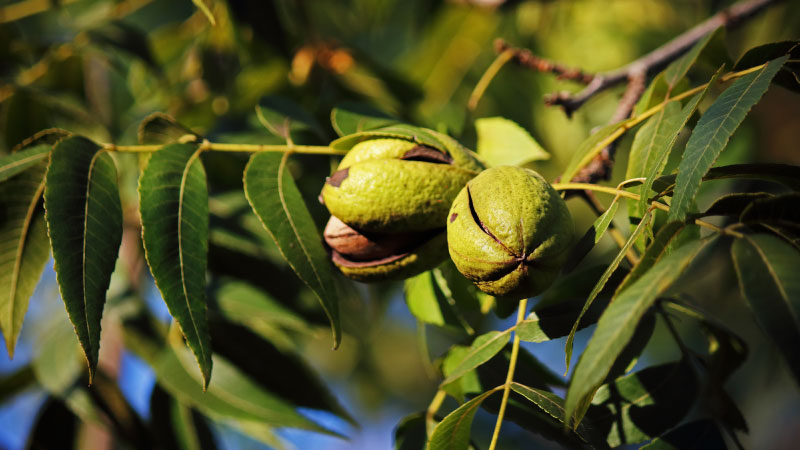How To Assess The Impact Of Salt On Irrigation Water
In the West, growers are often concerned about whether they will have access to a sufficient quantity of water to grow their crops; how-ever, the quality of the water can be just as important to consider as the quantity. Whether from the ground, a river, or recycled — all of these water sources can contain significant amounts of salts that may harm plants.
Salts reduce the osmotic potential of water, increasing the energy plants need for extracting moisture from soil, and making them more susceptible to wilting. In addition to contributing to water stress, some constituents of salts such as sodium, chloride, and boron are toxic if they accumulate in the leaves or other tissues. High sodium levels can also reduce the rate that water infiltrates into soil.

Salt affects irrigation equipment and can damage crops, as this photo of lettuce shows. Photo courtesy of Michael Cahn
Soils irrigated with alkaline water (high bicarbonate) may have reduced availability of micronutrients such as iron, copper, manganese, and zinc.
Lastly, salts can affect irrigation equipment by plugging drip emitters or by corroding metal fittings. All of these effects of salinity need to be considered when assessing the suitability of water for irrigation.
Testing The Water
Various measurements are used to characterize the salinity of irrigation water. The main tests are:
- Total dissolved solids (TDS),
- A measure of the bulk salinity and often determined indirectly by measuring electrical conductivity (EC);
- Sodium adsorption ratio (SAR), the ratio of sodium to the sum of calcium and magnesium; and
- Alkalinity, a measure of the bicarbonate dissolved in the water.
TDS and EC are useful for evaluating the osmotic effects of salts on crop growth. SAR is useful for assessing whether infiltration rates will be reduced or if sodium could potentially build up in the soil.
Measurements of alkalinity are used to assess if there is potential for calcium and magnesium carbonate to precipitate inside pipes and drip lines, or affect the pH of the soil.
While these three measures of salinity can give a general assessment of the suitability of water for crop production, tests are also needed to determine the types of salts present in the water.
Salts dissolve in water to form pairs of positively and negatively charged ions called cations (positively charged) and anions (negatively charged). The principal cations to test for in irrigation water are calcium, magnesium, sodium, and potassium, and the principal anions to test for are chloride, sulfate, carbonate, bicarbonate, and nitrate. Although iron and manganese are usually present at very low concentrations, they should also be included in water tests because they can form oxides that clog drip emitters.
The pH of the water, an indicator of the potential for bicarbonate to precipitate, should be measured too. Water should be tested for boron, which can cause toxicity in many species of plants. Test results are usually expressed in units of parts per million (ppm) or milliequivalents per liter (meq/L). Parts per million is also the same unit as milligrams per liter (mg/L).
What To Ask When Analyzing Results
When reviewing a water suitability report, several questions that affect crop production need to be answered:
- Will the bulk salinity of the water reduce the yield of the crop?
The Food and Agriculture Organization (FAO) publication, “Water Quality For Agriculture” available here: http://bit.ly/1tOsDgc, lists thresholds of salinity that cause yield loss for various vegetable crops. These thresholds should be used as rough guides, since actual values could vary significantly depending on climate, soil type, irrigation method, development stage of the crop, and the types of salts.Crops often can tolerate higher levels of salinity if calcium, magnesium, sulfate, and/or bicarb-onate represent a significant portion of the salinity in the water.This is because calcium and magnesium tend to precipitate out of the soil solution as the soil dries. Plants can often tolerate higher salinity levels in climates with low evapotranspiration demands, such as near the coast. In addition, mature plants are usually more tolerant to salinity than seedlings. - Are concentrations of sodium, chloride, boron, or bicarbonate at levels that would be toxic to a crop?
The FAO report also lists potential restrictions of water use due to specific ion toxicities. Sodium, chloride, and boron can accumulate in the stem and leaf tissues and build up to toxic levels. Tissues where the most water loss occurs, such as leaves, will often show toxicity symptoms first.Short season crops, including many vegetables, may not show toxicity symptoms to sodium and chloride while perennial crops may develop symptoms of toxicity after several seasons. Chloride toxicity often appears in leaves as interveinal chlorosis (yellowing) and marginal burning as the toxicity becomes more severe. Leaf burning can also be caused from absorption of these ions through the leaves during sprinkler irrigations. Try to avoid overhead sprinkling during periods of high evaporations, such as windy or hot conditions.Sensitivity to boron varies greatly between crops. Perennial crops such as trees and vines are usually more prone to boron toxicity than vegetable crops. Boron toxicity symptoms include the yellowing of leaves and marginal burns. - Will the infiltration rate be reduced?
High levels of sodium in the water can cause soil aggregates to disperse and form crusts on the soil surface that impede the infiltration of water. Poor infiltration will increase run-off from furrow and sprinkler systems. Irrigation water with a high EC will tend to infiltrate faster than water with a low EC. The FAO article presents the ranges of SAR and EC values that will reduce infiltration.
- Are there salt constituents that would lead to the clogging of drip emitters or micro-sprinklers?
The potential for salts to form precipitates is of special concern for micro-irrigation systems. Injection of fertilizers can sometimes cause salts to precipitate and clog drip emitters. Water with a high concentration of calcium or magnesium may form carbonate precipitates if the pH of the water is raised through the injection of alkali producing fertilizers, such as aqua ammonia.Also, the injection of fertilizers containing calcium can cause precipitates to form in water that is high in bicarbonate. Phosphorus fertilizers can create precipitates in water with high concentrations of calcium, and low concentrations of iron and manganese can oxidize and form precipitates capable of plugging drip emitters. Often, injecting fertilizers upstream of a filter system and using the appropriate combination of fertilizers can avoid many potential plugging problems downstream.
Evaluate Context Of Water Use
The quality of water needs to be evaluated in the context of the intended use. Testing water before designing a new drip system, purchasing or renting land, or switching to another crop will help avoid potential production problems and wasting money.
It is always advisable to check with a crop consultant or someone with experience in interpreting water tests to be sure that the intended water source is suitable for your crops.










